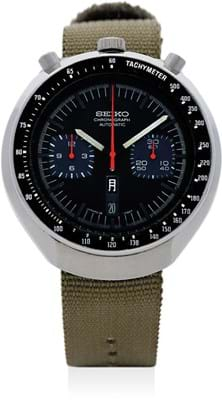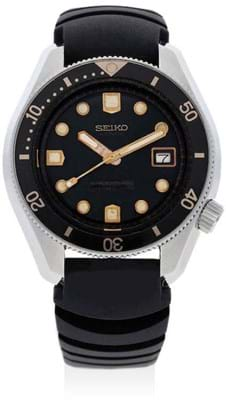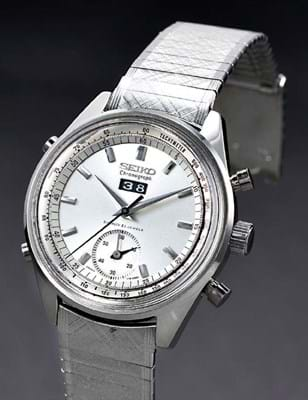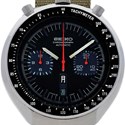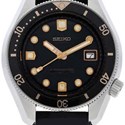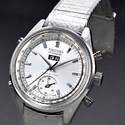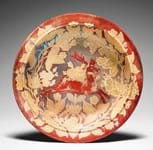In the run-up to Christmas 1969, the venerable Japanese firm Seiko unveiled a deluxe new wristwatch it called the Astron. Fashioned in a chunky 18ct gold case with a dressy leather strap, inside was an innovative tuning-fork-shaped quartz oscillator that allowed for remarkable accuracy.
The Astron had been aimed at the haute horlogerie market. Instead, its battery-powered technology precipitated the ‘quartz crisis’ that would hammer the Swiss watch industry and fuel the stereotype of ‘cheap Japanese timepieces’.
Seiko’s reputation as a maker of inexpensive watches for the masses has been hard to shake in the secondary market too. Collecting snobbery dictated that they lack status, heritage, exclusivity and – worst of all – soul. As the world’s richest men competed at the world’s biggest auction houses to own six-figure status symbols by a handful of Swiss brands, vintage Seikos did a good trade on eBay.
So when Bonhams Hong Kong (27.5/25% buyer’s premium) announced earlier this year it would be dispersing ‘one of the world’s largest and best’ collections of Seiko watches in a timed online sale titled Making Waves, the collecting community was encouraged that Seiko was being taken seriously in the world of vintage horology.
But Making Waves proved aptly titled for other reasons.
Not long after the catalogue went online on August 7, chat rooms and forums began to boil with claims of ‘after-market’ parts and ‘Frankenwatch’ rebuilds. Fratello, the popular online watch magazine, ran a story headlined ‘Bonhams Seiko Auction: A Dog’s Breakfast’. It was a cloudy start to Seiko’s moment in the sun.
Fortunately, some crisis management prevailed. Bonhams chose to delist the catalogue and when it returned the following week, the most problematic lots had been pulled from sale and transparent condition reports accompanied the remaining 170-odd pieces.
The front cover lot was one of the items that stayed in the sale which closed on August 25. This was the Ref 5718 chronograph produced specifically for the 1964 Tokyo summer Olympics where Seiko was official timekeeper. As a novel way to market Japan’s first chronograph, Seiko sold the watch to athletes in the Olympic village who admired its stopwatch, lap counter and tachymeter. It has the Seiko logo with the Olympic torch to the case back.
Some estimate that only 50 or so were made and only a handful are known so it is considered a ‘grail’ object for Seiko enthusiasts and the one piece across a vast collecting range that is priced in five figures.
The last 5718 to appear for sale sold for something like £20,000 in Japan in 2016. The present example had some condition issues (in addition to a damaged tachymeter ring the hands are probably later) but it went within hopes for a solid HK$110,000 (£11,000).
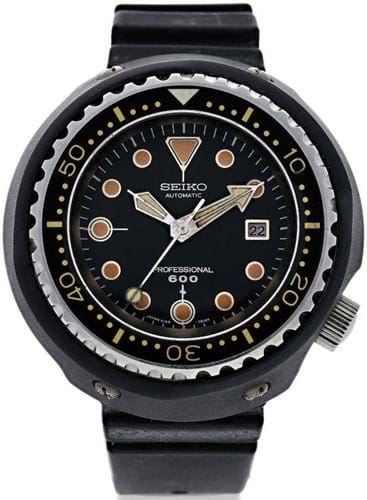
Ref 6159 Professional Diver’s 600m watch or Grandfather Tuna – HK$25,000 (£2500) at Bonhams Hong Kong.
Taking the plunge
The following year, in 1965, Seiko entered the market for recreational and professional diving watches. Japan’s answer to the Submariner and the Seamaster was a series of a tough and inventive dive watches available at a fraction of the price of a Rolex or and Omega. The firm set the trend for the large, asymmetrically shaped cushion cased divers that today shout 1970s.
Many variants were on offer here, including a rare Ref 6215 made for one year only in 1967. Despite its brief production run, the distinctive mono-bloc case with the crown situated at the four o’clock position, would become a hallmark of many Seiko divers. The merits of this particular example were much discussed online (as the dial and bezel showed very little sign of fading, they might have been later replacements) but it became the second most expensive lot in the sale at HK$55,000 (£5500).
The Ref 6215 was water resistant to 300m. Following seven years of research and testing by Seiko’s development team, the Ref 6159 or Tuna was issued in 1975. Made in titanium and ceramic, it could be used by commercial divers when working at depths up to 600m. The first of these, the Seiko Professional Diver’s 600m watch, is better known to collectors as the Grandfather Tuna. The example here sold for HK$25,000 (£2500).
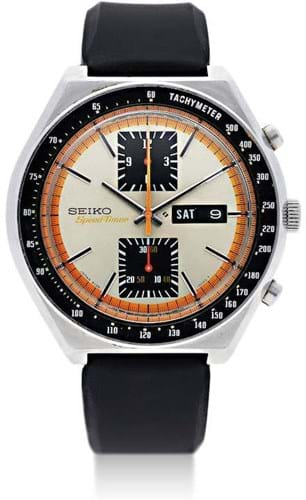
Ref 6138 Kakume or Square Eyes with champagne dial and black subs – HK$9000 (£900) at Bonhams Hong Kong.
In May 1969, Seiko launched the ‘5 Sports Speed Timer’ range housing the new 6138 calibre movement – beating Zenith, Breitling and Heuer to market with the world’s first automatic winding chronograph. Watches in the ‘Seiko 5 family’ have a 30-minutes counter, a tachymeter-scale bezel, and a day-date display with a quirky bilingual system: wearers could set it to read in English or Japanese.
Some of the issues from this golden era really do stand out from the crowd. The Bullhead with its cushion style case and the Kakume with square subsidiary dials have enjoyed a resurgence of popularity in recent years. They share a similar aesthetic, but a very different price bracket, with contemporary Heuer watches such as the Monaco and the Autavia.
Examples of the Bullhead sold here at HK$6000 (£600) for a version with a red/brown dial and gold subs and HK$9500 (£950) for a variant with a black dial with blue subs.
Kakumes (dubbed ‘Square Eyes’ in Japanese collecting circles) sold at HK$9000 (£900), for a watch with a champagne dial with black subs, and HK$7000 (£700) for another with a blue dial and silver subs.


